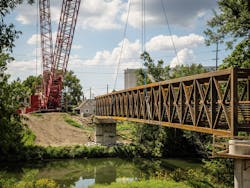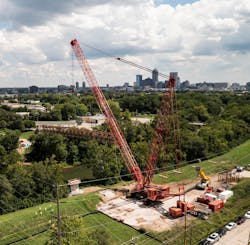Welcome to the Neighborhood
It’s not every day you look out of your bedroom window and see a crane boom jutting 200 feet in the air. That surprising sight became familiar for residents of a neighborhood in Indianapolis, Indiana, in August. A fire-engine red, 825-ton capacity Manitowoc 18000 lattice-boom crawler crane temporarily moved in alongside Fall Creek, providing a rare perspective of supersized lift equipment dwarfing two-story houses just a few yards away.
The purpose of the crane’s residency was to pick and set the three spans of a new 350-foot pedestrian bridge to stretch over the creek and connect the neighborhood to nearby walking paths. It’s the final piece in a federal project to create an uninterrupted trail network between downtown Indianapolis and Fort Benjamin Harrison.
Central Rent-A-Crane, a member of the ALL Family of Companies, supplied lift equipment, an operator, and strategic support for the bridge project. Tim Welty, sales representative, says the 18000’s role was dictated by location. Specifically, the location of the only piece of land available to assemble a crane.
“Fortunately, there is an empty lot across the creek from the neighborhood, where we could set up,” said Welty. “But from that position, the distance to set the middle section of the bridge is approximately 200 feet. We needed a powerful crane with high capacity even at extended reach, so we knew it had to be the Manitowoc 18000.”
Configured with 280 feet of main boom, the 18000 was tasked with lifting and setting the 200-foot middle section of the bridge, weighing in at 160,000 pounds, at a radius of a staggering 210 feet. The high-powered crane was able to make the reach at just 60% of capacity for that configuration.
Aiding the lift was a host of counterweights that added up to almost 1.5 million pounds – 492,000 pounds of standard counterweight, 320,000 pounds of car body weight, and 700,000 pounds on Manitowoc’s hanging MAX-ER wagon. The hanging MAX-ER free-floats as the crane swings. It attaches to the top of the mast by steel straps and to the rear of the upperworks by a shear frame.
Welty says it took more than 55 truckloads to deliver the Manitowoc 18000 to the site adjacent to the creek. Trucks also delivered the crane spans in different sections. Ironworkers assembled the spans on the ground so the crane could lift them. The large middle section consisted of four individual sections spliced together.
The 18000 stuck around to make quick work of the shorter bridge span nearest to the crane, with just a 70-foot radius needed for the 100-foot span.
Central brought in a smaller crane to handle the third and final span, also a shorter one, on the far side of the creek away from the empty lot. A 240-ton capacity Liebherr LTM 1200-5.1 all-terrain crane was able to set up on the neighborhood side of the creek to pick and set this final span.
About ALL
The ALL Family of Companies is the largest privately held crane rental and sales operation in North America, operating under the ALL, ALT, Central, Dawes, and Jeffers names. For a rental quote: 800-232-4100 or www.allcrane.com.

